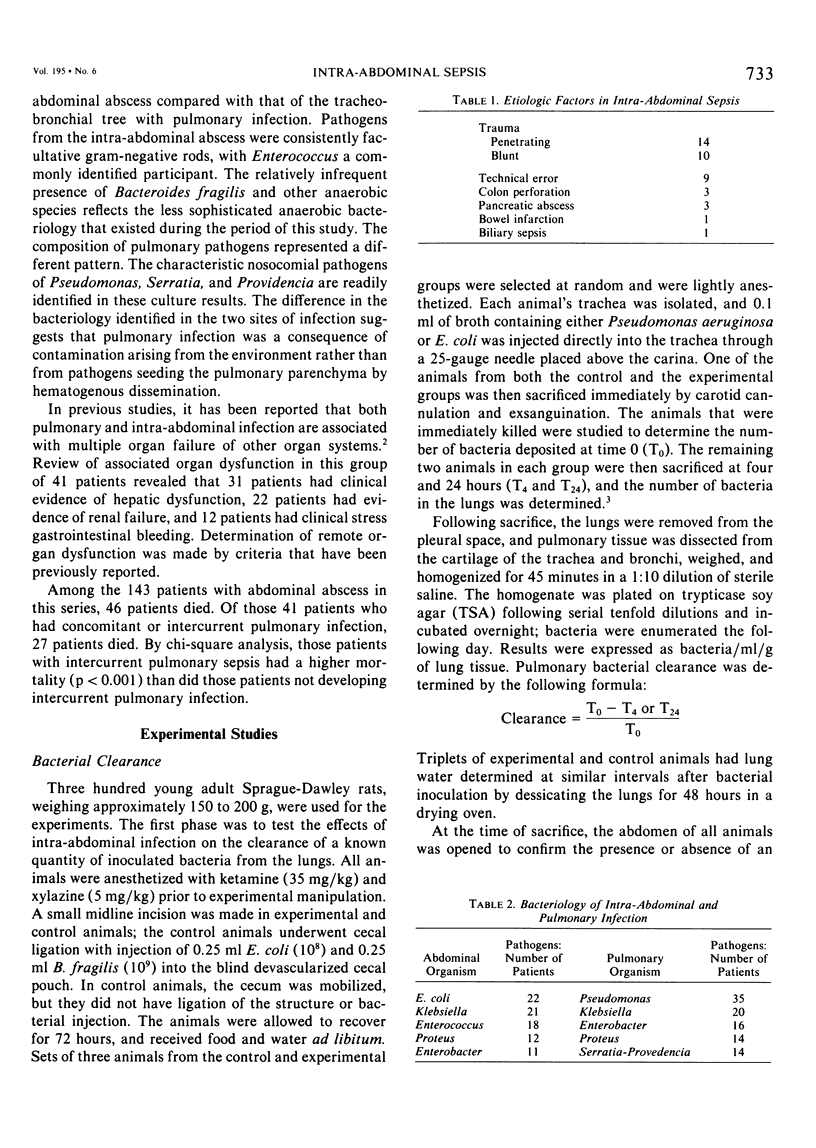Abstract
Pulmonary infection complicating intra-abdominal abscess is a major clinical problem. One hundred and forty-three patients with abdominal abscesses were reviewed; 41 had associated pneumonia by strictly defined criteria. The causative organisms for the pneumonia were Pseudomonas (35), Klebsiella (20), and Enterobacter (16), while abdominal infections were caused by Escherichia coli (22), Klebsiella (21), and Enterococcus (18). The temporal and bacteriologic relationship between the abdominal and pulmonary infection suggested that decreased pulmonary host defenses might be operative in the high incidence of pneumonia observed. An experimental model for intra-abdominal abscess was created using cecal ligation in the rat. Animals with an abdominal abscess had a marked depression of their ability to clear E. coli and Pseudomonas aeruginosa that were injected into the airway. Macrophages from infected animals did not differ in quantity or viability when compared with those in control animals. The ability to ingest bacteria appeared to be normal or enhanced in infected animals, but there was a significant decrease in the ability of the macrophage to kill the ingested organisms. Such macrophage defects may be partially responsible for the infected animals' inability to clear bacteria in a normal manner.
Full text
PDF





Selected References
These references are in PubMed. This may not be the complete list of references from this article.
- Brain J. D., Frank N. R. Recovery of free cells from rat lungs by repeated washings. J Appl Physiol. 1968 Jul;25(1):63–69. doi: 10.1152/jappl.1968.25.1.63. [DOI] [PubMed] [Google Scholar]
- Fry D. E., Garrison R. N., Heitsch R. C., Calhoun K., Polk H. C., Jr Determinants of death in patients with intraabdominal abscess. Surgery. 1980 Oct;88(4):517–523. [PubMed] [Google Scholar]
- Fry D. E., Pearlstein L., Fulton R. L., Polk H. C., Jr Multiple system organ failure. The role of uncontrolled infection. Arch Surg. 1980 Feb;115(2):136–140. doi: 10.1001/archsurg.1980.01380020006003. [DOI] [PubMed] [Google Scholar]
- Fulton R. L., Jones C. E. The cause of post-traumatic pulmonary insufficiency in man. Surg Gynecol Obstet. 1975 Feb;140(2):179–186. [PubMed] [Google Scholar]
- Kim M., Goldstein E., Lewis J. P., Lippert W., Warshauer D. Murine pulmonary alveolar macrophages: rates of bacterial ingestion, inactivation, and destruction. J Infect Dis. 1976 Mar;133(3):310–320. doi: 10.1093/infdis/133.3.310. [DOI] [PubMed] [Google Scholar]
- MYRVIK Q., LEAKE E. S., FARISS B. Studies on pulmonary alveolar macrophages from the normal rabbit: a technique to procure them in a high state of purity. J Immunol. 1961 Feb;86:128–132. [PubMed] [Google Scholar]
- Richardson J. D., Fry D. E., Van Arsdall L., Flint L. M., Jr Delayed pulmonary clearance of gram-negative bacteria: the role of intraperitoneal sepsis. J Surg Res. 1979 May;26(5):499–503. doi: 10.1016/0022-4804(79)90040-4. [DOI] [PubMed] [Google Scholar]
- Richardson J. D., Woods D., Johanson W. G., Jr, Trinkle J. K. Lung bacterial clearance following pulmonary contusion. Surgery. 1979 Nov;86(5):730–735. [PubMed] [Google Scholar]
- Siegel J. H., Cerra F. B., Coleman B., Giovannini I., Shetye M., Border J. R., McMenamy R. H. Physiological and metabolic correlations in human sepsis. Invited commentary. Surgery. 1979 Aug;86(2):163–193. [PubMed] [Google Scholar]
- Walker L., Eiseman B. The changing pattern of post-traumatic respiratory distress syndrome. Ann Surg. 1975 May;181(5):693–697. doi: 10.1097/00000658-197505000-00025. [DOI] [PMC free article] [PubMed] [Google Scholar]


